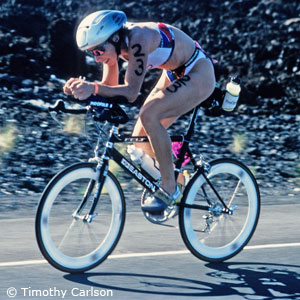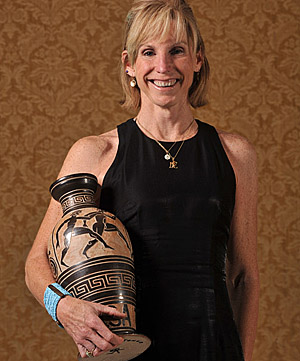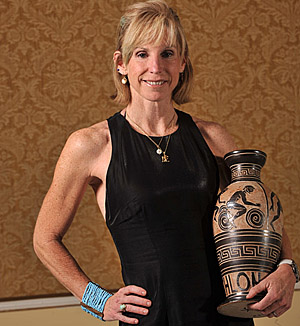It’s not so easy – part 1

"What follows is a 4-part series printed with the publisher's permission from "17 Hours to Glory: Extraordinary Stories from the Heart of Triathlon by Mathias Müller with Timothy Carlson." 17 Hours to Glory celebrates Kona’s Ironman® heroes—from ordinary people to true triathlon legends—with seventeen inspiring stories of unbelievable drive and true strength of character. The book is available in bookstores, tri shops, and online at VeloPress.com."
The greatest Ironman triathlete of all time was born in Salisbury, Southern Rhodesia (now Harare, Zimbabwe), and raised in Durban, South Africa. “I was a good girl growing up. A very good girl,” Paula Newby-Fraser told writer TJ Murphy about her childhood. Her father was a wealthy industrialist who owned a paint factory. Her mother was a university lecturer in psychology and social sciences. Newby-Fraser studied hard, got good grades, and excelled at ballet and swimming.
Her government-controlled all-girls school was strict. “The choices were limited. You did what you were told. You just did,” she recalled. At school the girls lined up every week for inspection, shortest to tallest. No talking, no earrings, no makeup. Lengths of skirts and fingernails were checked.
The outlet she found was sports. “Because there were no boys around, we didn’t have the social dimension to think about, to take up our energy,” she said. “Instead we focused on things like sports.” Girls who performed well at games were praised at assemblies and cheered by the crowd. But a career in sports was unthinkable. Proper girls married well or became teachers.
Ever practical, she embraced the discipline of her early schooling and studied social sciences at the University of Natal in Durban. After graduating in 1984, she ditched academic life and embraced the town’s active party scene. When a friend said she was getting fat, they started running together and lifting weights. Sparked by her increasing fitness, Newby-Fraser checked out a local triathlon with her boyfriend. Though she thought the challenge was slightly ridiculous, her boyfriend convinced her to give the event a try the following year, and they bought bicycles and began training. Only 8 weeks after buying the bike Newby-Fraser won her first triathlon, setting a new women’s record for the course. She also finished 4th among the men, giving a hint of her power to come. Three months later she won the women’s division of the South African Triathlon and won a free trip to Hawaii to compete in the famed Ironman Triathlon.
There, in 1985, virtually unknown and relying on raw talent (she had never swum 2.4 miles, biked 112 miles, or run a marathon), she placed 3rd. Moreover, she finished just 5 minutes 42 seconds behind the women’s winner, Joanne Ernst. That performance, along with what she had learned in preparation for the race, convinced Newby-Fraser that additional training could give her the tools to win.
On her way to Hawaii Newby-Fraser had stopped in San Diego—triathlon’s original mecca—and found a collective passion for the sport among the pioneers. In a story in Encinitas magazine, she said, “I planned to visit San Diego because of the great athletes that were there, like Scott Tinley, Mark Montgomery, and Colleen Cannon. I stayed at a friend’s in Leucadia and started doing all the famous workouts: the Tuesday run in Rancho Santa Fe, the Wednesday bike ride, swimming and track workouts at UCSD.”
When Newby-Fraser returned to South Africa she couldn’t shake Encinitas from her mind. “All I could think of was that I had to get back,” she said. After talking it over with her parents, she flew back to America with $1,000 in her pocket and moved into an apartment with fellow triathletes Linda Janelli and Maggie Smeal. During those first months she met the man who would become the lasting love of her life, Paul Huddle, an elite triathlete now recognized as one of the best triathlon coaches in the world.
In her second Hawaii Ironman in 1986 she eased into history when 1st-place finisher Patricia Puntous was disqualified for drafting and Newby-Fraser, who crossed the line 2 minutes later, inherited the victory. She was awarded the $10,000-plus top prize, the first year the event offered a pro purse. When she heard that she had won, Newby-Fraser seemed stunned. “I just feel that I have no control over the situation,” she told journalist Mike Plant. “I feel for her, but I have no control. I’m pleased that I’ve won now, but that’s just the way it goes.”
While her victory may have felt anticlimactic, Newby-Fraser’s winning time was a clap of thunder announcing the arrival of professional women to the sport. Her 9:49:14 mark broke the previous record by 36 minutes, and she was the first woman to break the Ironman 10-hour mark. Her finish would have won the men’s division in the first two Ironman contests and would have placed 2nd to the top man in the 1980 and 1981 events.
In 1987 Newby-Fraser started strong, holding the lead for 21 miles of the marathon, but then faded in the brutal heat. Two-time winner Sylviane Puntous of Canada, Patricia Puntous’s twin, was stalking her all day, and New Zealand star Erin Baker, a superb 2:36 marathoner and excellent short- and long-course triathlon star, caught both of them at mile 22. Newby-Fraser was tapped and could not fight back. Puntous, as was her habit in the early years of the sport, walked through the aid stations while the fierce newcomer Baker, shocked at the Canadian’s lack of warrior ethic, stormed past to a new record time of 9:35:25, with Puntous 1:32 back. Although she had broken her own 1986 course record by 9 minutes, Newby-Fraser fell to 3rd.
Afterward, Plant wrote, Newby-Fraser realized that winning the Ironman would demand her full attention. For her part, Baker said, “I had to concentrate like hell to get to the finish. I didn’t have anything left. I couldn’t smile.” From that point forward, every woman knew she would have to run every mile of the marathon to prevail.
Newby-Fraser’s remarkable Ironman finish in 1988 was the shot heard ’round the world of sport. Rival Erin Baker upped the ante tremendously, topping her year-old record by 23 minutes with a 9:12:14 finish. But Newby-Fraser slaughtered Baker by 11 minutes and her old standard by 34 minutes with a 9:01:01 finish. Indeed, Newby-Fraser appeared to be in a league of her own; her greatest rivals were men. She finished 11th overall, just a breath over 30 minutes behind the men’s overall winner, Scott Molina, and along the way she bested a string of certified men’s stars, including her boyfriend, Paul Huddle, by 3:45; Greg Welch by 6:13; Jeff Devlin by 9:53; and Peter Kropko by an amazing 20:36.
For all Joan Benoit Samuelson’s greatness, she never finished near the top 11 at Boston or in the Olympics. Florence Griffith Joyner would not have qualified for the men’s Olympic team. Only Ann Trason, who finished the 1995 Western States 100-mile trail run just 5 minutes behind the men’s winner, was in the same area code as Newby-Fraser in women’s remarkable push toward equality in endurance sports.
But Newby-Fraser, who maintained a highly disciplined, scientific approach to the sport throughout her career, was never carried away by the hype over her 1988 feat. “That year I had a good performance, and the men lagged,” she remembered. “The next year I went just a little bit quicker, but I was 51 minutes back of [men’s winner] Mark Allen. Had Mark been winning the race in 1988, the gap would not have been as small as it was.”
Over the next three editions of Ironman Hawaii, Newby-Fraser racked up similarly impressive results. In 1989 she topped women’s runner-up Puntous by 21 minutes. The next year, on a hot day, she proved she was human and lost another duel to Erin Baker, 9:13:42 to 9:20:01. She came back in 1991 to beat Baker by nearly 16 minutes, giving her four wins in six years—a record that many an athlete might happily call a career. Yet all of these performances were but a buildup to one of the most remarkable years recorded by any athlete in triathlon.
Part 2 tomorrow.
Not all images feature in our story are part of the book.



